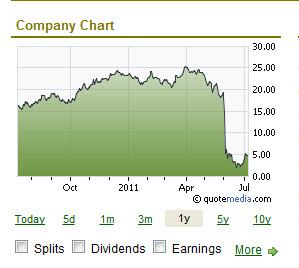Sino-Forest is a commercial forest plantation operator in China. Its principal businesses include owning and managing plantation forests, the sale of standing timber and wood logs and manufacturing engineered-wood products. The majority of the tree plantations and operations are located in southern and eastern China, primarily in inland regions suitable for large-scale replanting.
On March 11, 2011, Ernst & Young issued an Independent Auditors’ Report on Sino-Forest Corporation. The auditors said, “In our opinion, the consolidated financial statements present fairly, in all material respects, the financial position of Sino-Forest corporation as at December 31, 2010 and 2009 and the results of its operations and cash flows for the years then ended in accordance with Canadian generally accepted accounting principles.”[1]
This report is the same one issued for thousands of other companies and really doesn’t tell the reader much. But, wouldn’t an interested reader want to know just what the Canadian auditors at Ernst did to check the inventory in China. What records did it inspect? How many tree plantations did the auditors visit? Who did the work – were they qualified to do it? Was it people from Ernst’s Toronto office, which signed the report, or people from a Chinese affiliate? How many auditors did the work and how quickly was it done (was it cursory or extensive)? How did they verify ownership of the underlying assets of the company?
Three months later on June 2, 2011, Muddy Waters Research issued a report that said, “As Bernard Madoff reminds us, when an established institution commits fraud, the fraud can become stratospheric in size. Sino-Forest Corp. (“TRE”) is such an established institutional fraud, becoming massive due to its early start, luck, and deft navigation. At nearly seven billion dollars in enterprise value, it will now end.”
Now that’s an opening in a report I’m sure most readers would want to pursue reading!
The result of that report was a dramatic drop in Sino-Forest’s stock price:
Now, Muddy Waters Research is in the business of short selling stock. Depending on the size of its investment, Muddy Waters made a lot of money! But they backed up their assertion that Sino-Forest was a fraudulent company with a significant amount of information. They said:
· The foundation of TRE’s fraud is its convoluted structure whereby it runs most of its revenues through “authorized intermediaries” (“AI”). AIs supposedly process TRE’s tax payments, which ensures that TRE leaves its auditors far less of a paper trail.
· On the other side of its books, TRE massively exaggerates its assets. We present smoking gun evidence that TRE overstated its Yunnan timber investments by approximately $900 million.
· TRE relies on Jakko Pöyry to produce reports that give it legitimacy.[2] TRE provides fraudulent data to Pöyry, which produces reports that do nothing to ensure that TRE is legitimate.
· TRE’s capital raising is a multi-billion dollar ponzi scheme, and accompanied by substantial theft.
I also reviewed Jakko Pöyry’s report and was surprised at the significant disclaimers, including: “Pöyry makes no representation or warranty, expressed or implied, as to the accuracy or completeness of the information provided in this report or any other representation or warranty whatsoever concerning this report. This report is partly based on information that is not within Pöyry’s control. Statements in this report involving estimates are subject to change and actual amounts may differ materially from those described in this report depending on a variety of factors.”
Do we know if, in fact, Ernst relied, in part, on this work in making its audit opinion? Did Ernst do its own assessment of the value of the timber reported on Sino-Forests balance sheet? The reader wouldn’t know by reading the audit report.
In most government audit reports, the auditor’s report includes a description of the audit objectives, and the scope and methodology used for addressing the audit objectives. This information gives the reader an understanding of the purpose of the audit, the nature and extent of the audit work performed, the context and perspective regarding what is reported, and any significant limitations in audit objectives, scope, or methodology.
Maybe the public auditors could take a lesson from their government counterparts and provide us with more comprehensive information supporting the audit opinions that are offered today.
The Canadian Globe and Mail followed up on the Muddy Water report and said: “During two weeks of on-the-ground reporting that included interviews with Chinese government officials, forestry experts, local business operators and brokers, The Globe and Mail uncovered a number of glaring inconsistencies that raise doubts about the company’s public statements regarding the value of the assets that lie at the centre of the company’s core business of buying and selling Chinese timber rights.”
If Ernst & Young did not properly establish the value of the assets owned by Sino-Forest they failed in their audit responsibilities. If they accepted an assignment in Canada that required extensive work in China, but didn’t assign staff to do the verification work required, shame on them.
If we had a more comprehensive audit report that explained the work done, we might be better able to make more informed decisions about the validity of the auditors’ work.
If it turns out that Sino-Forest is committing fraud, I feel sorry for the investors and creditors who depended on the auditors’ report.

